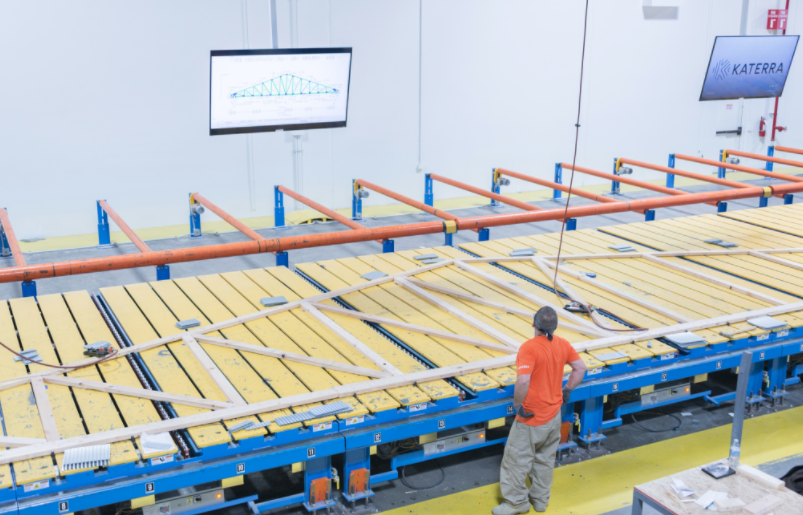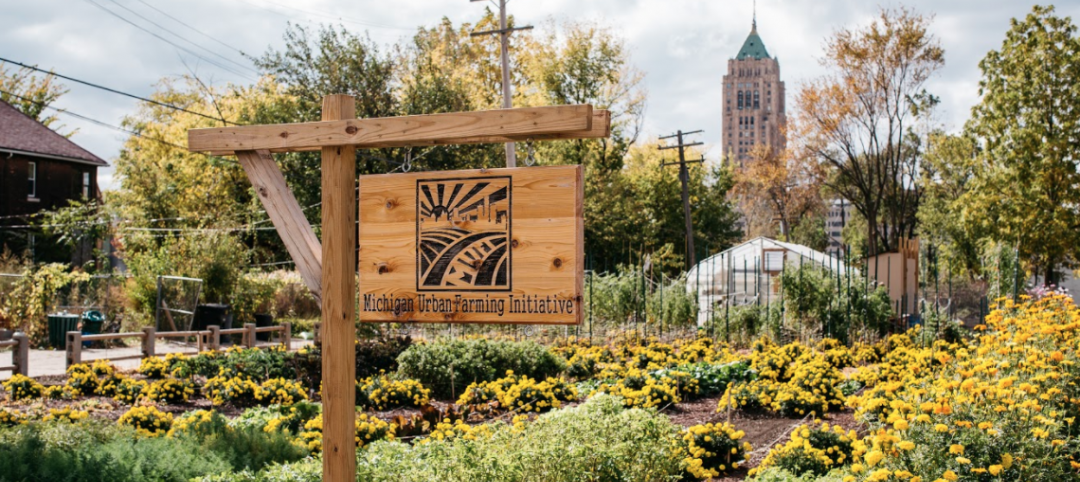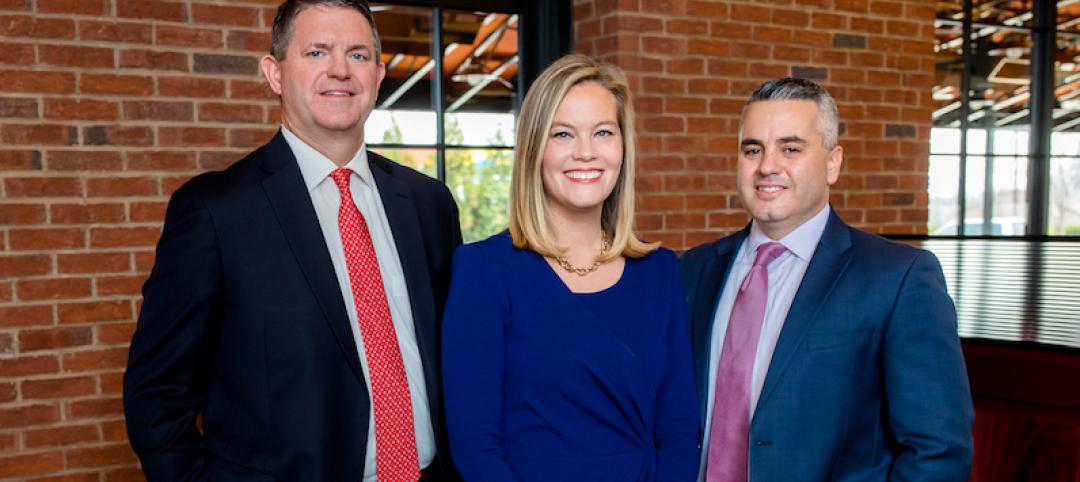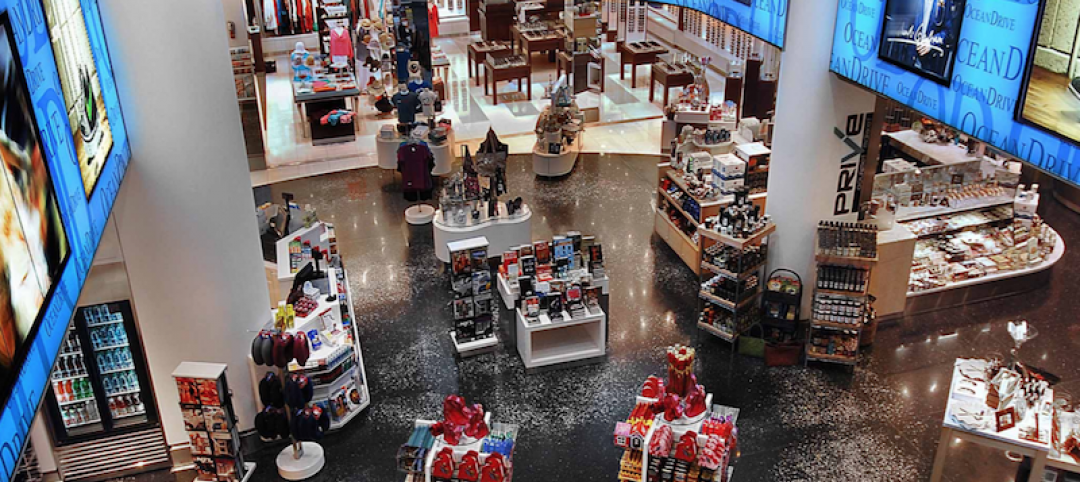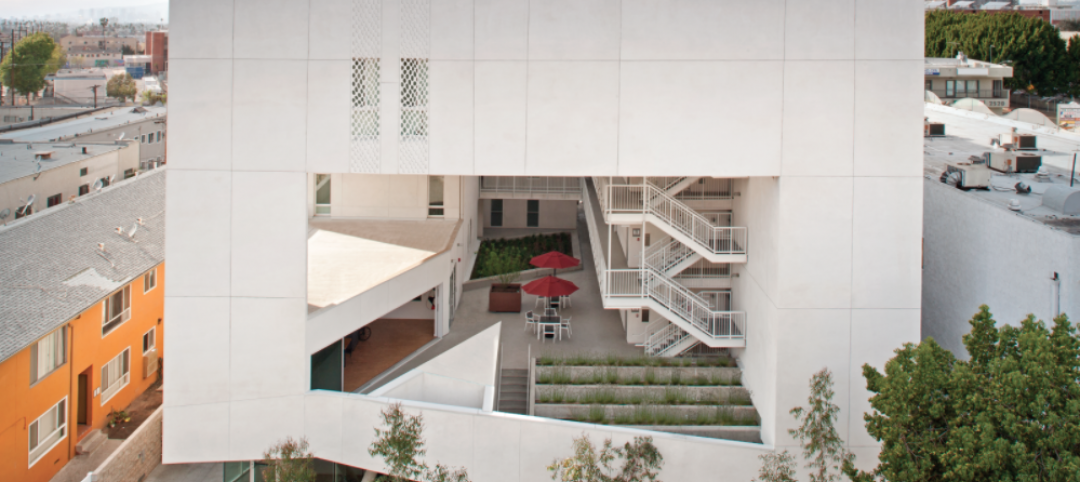By this time next year, Katerra—a technology startup whose end-to-end business model combines prefabrication, architectural, and construction services primarily for multifamily housing—expects to have six manufacturing plants up and running, including its first mass timber factory, a 250,000-sf building under construction on 29 acres in Spokane, Wash.
That plant, when fully operational in early 2019, will be capable of producing about 4.6 million cubic feet of cross-laminated timber annually. The plant’s size is comparable to CLT factories operating in Europe. “We’re going all in on CLT,” says Trevor Schick, who oversees Katerra’s supply chain, lighting, renovation, and commercial rollout activities.
Katerra’s initial success—it booked $1.3 billion in business last year—and its aggressive growth posture have attracted several high-profile investors, most prominently Japan’s SoftBank, from whose $100 billion Vision Fund Katerra recently raised $865 million in its latest round of financing.
SoftBank is steadily investing in tech-oriented companies that are impacting the built environment. In December, it paid $9.3 billion to acquire a 15% stake in Uber Technologies. It owns the robotics manufacturer and research firm Boston Dynamics. Last summer, SoftBank invested $200 million in the indoor farming enterprise Plenty. And it holds a $4.4 billion stake in WeWork, the cosharing office developer.
TechCrunch reported that the venture-capital world fully expects SoftBank to raise another $100 billion for future investments soon.
In-house design team and consortium
The Menlo Park, Calif.-based Katerra is already among the country’s largest GCs. The housing markets it serves include multifamily, senior and student living, and master-planned developments. Katerra’s largest customer is The Wolff Company, a real estate private equity firm that focuses on the multifamily sector, and whose executive chairman Fritz Wolff was one of Katerra’s Co-founders.
“Having a lead customer is important, given the investment we’re making in factories, IT, and so forth,” says Schick.
Katerra currently produces wall panels, roof and floor trusses, cabinets, and countertops from its factory in Phoenix, which began production in early 2017. That facility features Katerra’s Design Showroom, where clients can view a full suite of products and interior design solutions, including fully finished apartment units made entirely from Katerra-supplied products.
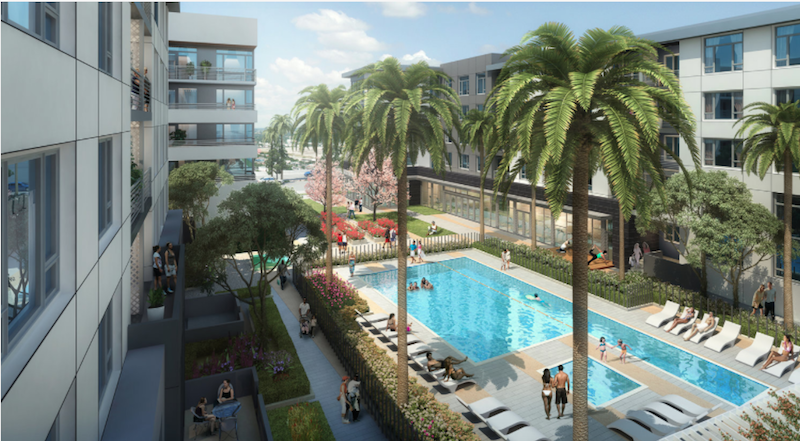 Union Bay South in Carson, Calif., designed by Architects Orange, will offer 357 residential units, with four- and five-story wood framed buildings wrapping two separate concrete parking structures. The building, currently under construction, will include 30,000 sf of retail. Katerra is providing construction, management, and materials. Image: Katerra
Union Bay South in Carson, Calif., designed by Architects Orange, will offer 357 residential units, with four- and five-story wood framed buildings wrapping two separate concrete parking structures. The building, currently under construction, will include 30,000 sf of retail. Katerra is providing construction, management, and materials. Image: Katerra
Last June, Katerra acquired Nystrom Olson, a boutique architectural studio in Spokane. And six months later, it announced the forming of a design consortium whose members include Michael Green of Michael Green Architecture, a leader in mass timber architectural design; Andrea Leers of Boston-based Leers Weinzapfel Associates, which has also designed buildings using mass timber; Ted Flato of Lake|Flato in Texas; and Joe Greco of Lord Aeck Sargent, a full-service architecture and design firm with six offices.
With Green, Katerra is working on the design and construction of the new Hospitality Center in association with the Community Cancer Fund, Ronald McDonald House and Kootenai Health (Walden House) in Coeur d’Alene, Idaho.
Schick tells BD+C that, aside from the CLT plant in Washington, the other facilities Katerra moves into or builds this year will be conventional wood panel and truss factories. Its next mass timber plant is likely to be located in the Southeastern U.S., although Schick didn’t say when construction for that might start.
Leaning toward mass production
Katerra started as a materials supplier, with sourcing offices in Asia and Mexico. But the company soon realized that it needed a “larger scale” to get its cost model right, says Schick. That meant taking more control over the design, production, construction, and logistics of what it sold.
Technology has been the key to that transformation. Before joining Katerra, Schick spent over 15 years in the electronics industry, most recently as senior vice president at Hewlett-Packard involved in global supply chain and quality. One of Katerra’s Co-founders, Michael Marks, had been CEO of an electronics company now called Flex. A third Co-founder, Jim Davidson, founded Silver Lake, a technology investment firm.
Marks is convinced that building construction would benefit greatly from mass production techniques that are common in electronics and automotive manufacturing. Consequently, Katerra uses a kit-of-parts design system that it combines with prefabricated components production and onsite assembly.
The company’s technology platforms include SAP HANA, a market analytics platform that mines data from real estate and construction; a mobile app that connects its workforce in the field; and industrial IoT tools that optimize jobsite activity and track inventory.
 Katerra is building its first mass timber factory, a 250,000-sf building in Spokane, Wash., which will be able to produce 4.6 million cubic feet of product annually. Image: Katerra
Katerra is building its first mass timber factory, a 250,000-sf building in Spokane, Wash., which will be able to produce 4.6 million cubic feet of product annually. Image: Katerra
Schick says the company currently has 12 multifamily projects under way, ranging from 200 to 400 housing units per project. Sometime this year, he says the company plans to enter the hotel construction sector. Katerra also wants to build schools eventually.
As for projects using mass timber, Schick believes that demand among developers, contractors, and cities can only go up. He notes that the International Code Council has a vote scheduled for April to amend the 2021 International Building Code to allow for the use of CLT for buildings up to 18 stories. (Currently, CLT is limited in the U.S. to buildings no higher than six stories.)
In Washington State, ESB Bill 5450, which has passed both chambers of the legislature and is on the governor’s desk to sign, creates a section in the state statute defining qualifying mass timber products. It also directs the State Building Code Council to adopt rules for the use of mass timber in residential and commercial building, consistent with application national and international standards.
Katerra is already doing fire, earthquake, and wind sheer testing of CLT panels that it can make on its 60-foot-long by 12-foot-wide press.
Related Stories
Game Changers | Dec 20, 2017
Urban farms can help plant seeds for cities’ growth around them
Urban farms have been impacting cities’ agribusiness—and, on some cases, their redevelopment—for decades.
Public Health Labs | Dec 19, 2017
10 takeaways from SmithGroup’s ‘lab of the future’ initiative
The LAB2050 initiative digs into the scientific trends, technologies, and economics that will shape tomorrow’s research laboratory environments.
Contractors | Dec 18, 2017
HITT Contracting names next generation of leadership
Executive Vice President Kim Roy has been named CEO.
Multifamily Housing | Dec 12, 2017
Call for technical experts: Dog wash station design
The editors of Multifamily Design + Construction magazine need your expertise.
Multifamily Housing | Nov 29, 2017
First Porsche, now Aston Martin: Sports car maker co-develops Miami condo tower *UPDATED
The 391-unit Aston Martin Residences will feature seven penthouses and a duplex penthouse, all with private pools and terraces overlooking Biscayne Bay.
Industry Research | Nov 28, 2017
2018 outlook: Economists point to slowdown, AEC professionals say ‘no way’
Multifamily housing and senior living developments head the list of the hottest sectors heading into 2018, according a survey of 356 AEC professionals.
Continuing Education and Life Time Learning | Nov 22, 2017
A new vocational center in Colorado hones high school students' woodworking and construction skills
The MILL National Training Center will extend its curriculum to vets and businesses in 2018.
Multifamily Housing | Nov 15, 2017
6 noteworthy multifamily developments: artists housing, tech lofts, resort-style senior living
These recently completed projects represent emerging trends and design innovations in the multifamily sector.
Contractors | Nov 13, 2017
CBRE completes acquisition of Heery International
The deal is expected to expand the real-estate firm’s project management capacities in several U.S. sectors.
Multifamily Housing | Nov 8, 2017
No place like home: LA’s The Six provides permanent supportive housing for veterans
The 52-unit development gives hope and dignity to homeless or disabled veterans and others in need.


